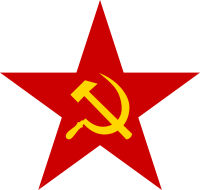New Communist movement
| New Communist Movement | |||
|---|---|---|---|
| Part of Communism in the United States | |||
| Location | United States | ||
| Goals | Communism | ||
| Parties to the civil conflict | |||
| |||
| Part of a series on |
| Communism |
|---|
 |
|
Concepts
|
|
Internationals |
|
Related topics |
|
|
The New Communist Movement (NCM) was a Marxist-Leninist political movement of the 1970s and 1980s in the United States. The term refers to a specific trend in the U.S. New Left which sought inspiration in the experience of the Russian Revolution, the Chinese Communist Revolution, and the Cuban Revolution, but wanted to do so independently of already-existing U.S. communist parties.
Origins
In the 1960s, student activists gathered into the Students for a Democratic Society. The SDS grew to over 100,000 members before splitting in 1969. One of these splits, Revolutionary Youth Movement II, quickly splintered into a large number of small Maoist groups. These groups collectively became known as the New Communist Movement .
Developments in the 1970s and 1980s
As one of its last initiatives, SDS had begun to leave its campus base and organize in working-class neighborhoods. Radical militant groups such as Weather Underground are recognized as participants in the movement. Some former members subsequently developed local organizations that continued the trend, and they attempted to find theoretical backing for their work in the writings of Vladimir Lenin, Mao Zedong and Joseph Stalin. Maoism was then highly regarded as more actively revolutionary than the brand of communism supported by the post-Stalin Soviet Union (see New Left: New Left in the United States). As a result, most NCM organizations referred to their ideology as Marxism-Leninism-Mao Zedong Thought.
Similar to the New Left's general direction in the late 1960s, these new organizations rejected the post-1956 Communist Party USA as revisionist, or anti-revolutionary, and also rejected Trotskyism and the Socialist Workers Party for its theoretical opposition to Maoism.
The groups, formed of ex-students, attempted to establish links with the working class through finding work in factories and heavy industry, but they also tended toward Third-worldism, supporting National Liberation Fronts of various kinds, including the Black Panther Party (then on the decline), the Cuban Revolution, and the National Front for the Liberation of Vietnam. The New Communist Movement organizations supported national self-determination for most ethnic groups, especially blacks and those of Latino origin, in the United States. These organizations addressed problems of sexism and racism, partly by voicing adamant support for self-determination and identity politics, and felt that they were dealing with problems they were of the opinion had not been addressed in the groups of the 1960s. However, different NCM groups came to this similar conclusion via quite different routes.
In its early years, NCM organisations formed a loose-knit tendency in United States leftist politics, but never coalesced into a single organization. As time went on, the organizations became extremely competitive and increasingly denounced one another. Points of distinction were frequently founded on the attitude taken toward the successors of Mao and international disputes between the Soviet Union and China regarding such developments as the Angolan Civil War. The Revolutionary Union organized the founding congress of the Revolutionary Communist Party, USA in 1975.
The October League organized the founding congress of the Communist Party (Marxist-Leninist) in 1977. During this period a few other new communist movement organizations also formed new communist parties.
Unlike the majority of NCM groups, the Dodge Revolutionary Union Movement (DRUM), which evolved into the League of Revolutionary Black Workers (LRBW), was formed by factory workers rather than student activists. The AFL-CIO leadership supported the Vietnam War and sought to avoid strikes, but union workers saw through this and independently organized a series of wildcat strikes. Radical Marxist and other African-American auto workers subsequently formed DRUM. From 1968 to 1971 DRUM and the league acted as a dual union, with black leadership, within the United Auto Workers. In the late 1970s a group labeled the May 19th Communist Organization was created, going on a bombing campaign.
The New Communist Movement as a whole became smaller in the 1980s. The militant May 19th Communist Organization was dissolved. Some organizations dissolved in the early 1980s, such as the Communist Party (Marxist-Leninist). The Revolutionary Communist Party USA remains as an original product of the New Left. The Revolutionary Workers Headquarters and Proletarian Unity League joined forces to form the Freedom Road Socialist Organization in 1985, and various other new communist movement collectives and organizations later merged into FRSO. Subsequently, in 1999, FRSO split into two organizations, both of which continue to use the name Freedom Road Socialist Organization.
Organizations
Predecessors
- Provisional Organizing Committee for a Communist Party
- Bay Area Revolutionary Union
- Black Panther Party
- Dodge Revolutionary Union Movement
- Revolutionary Youth Movement II
- Students for a Democratic Society
NCM organizations of the 1970s and 1980s
- Black Panther Party
- Committee for a Proletarian Party
- Communist Organization, Bay Area
- Communist Party (Marxist-Leninist)
- Communist Workers Party
- Georgia Communist League
- The Guardian
- League of Revolutionary Struggle
- Marxist-Leninist Party, USA
- May 19th Communist Organization
- October League
- Organization for Revolutionary Unity
- Proletarian Unity League
- Revolutionary Communist Party
- Revolutionary Union
- Revolutionary Workers Headquarters
- Revolutionary Workers Organization
- Sojourner Truth Organization
- Venceremos Organization
- Weather Underground
Current organizations descended from NCM
- Freedom Road Socialist Organization
- League of Revolutionaries for a New America
- Revolutionary Communist Party, USA
See also
Further reading
- Max Elbaum, Revolution in the Air: Sixties Radicals Turn to Lenin, Mao, and Che (London: Verso, 2003).
{{URL|example.com|optional display text}} - Paul Saba, "Theoretical Practice in the New Communist Movement: An Interview with Paul Saba," Viewpoint Magazine, August 25, 2015.